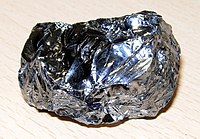
Photo from wikipedia
In Czochralski silicon (CZ-Si) crystal growth, species generated from high temperature reactions and transported by Si melt and argon (Ar) gas strongly affect the purity and quality of the grown… Click to show full abstract
In Czochralski silicon (CZ-Si) crystal growth, species generated from high temperature reactions and transported by Si melt and argon (Ar) gas strongly affect the purity and quality of the grown crystals. The reduction of carbon (C) contamination in crystal is required for producing Si wafers with long carrier lifetimes. Advances in the modeling of C contamination in CZ-Si growth are reviewed on the basis of the mass transport phenomena in the Ar gas and Si domains. The generation, incorporation, and accumulation of C were investigated by the transient global simulations of heat and mass transport during the melting process of CZ-Si growth. In addition to graphite etching, two additional sources of carbon monoxide (CO) were analyzed according to their contributions to the accumulation of C in the Si melt. The effect of gas flow control on the back diffusion of the generated CO was examined via a parametric study of the furnace pressure and the Ar gas flow rate. Strategies for C content reduction are discussed on the basis of the mechanisms of C accumulation, which indicate that the final C content depends on both the growth duration as well as the flux of contaminants at the gas/melt interface.
Journal Title: Crystal Research and Technology
Year Published: 2017
Link to full text (if available)
Share on Social Media: Sign Up to like & get
recommendations!